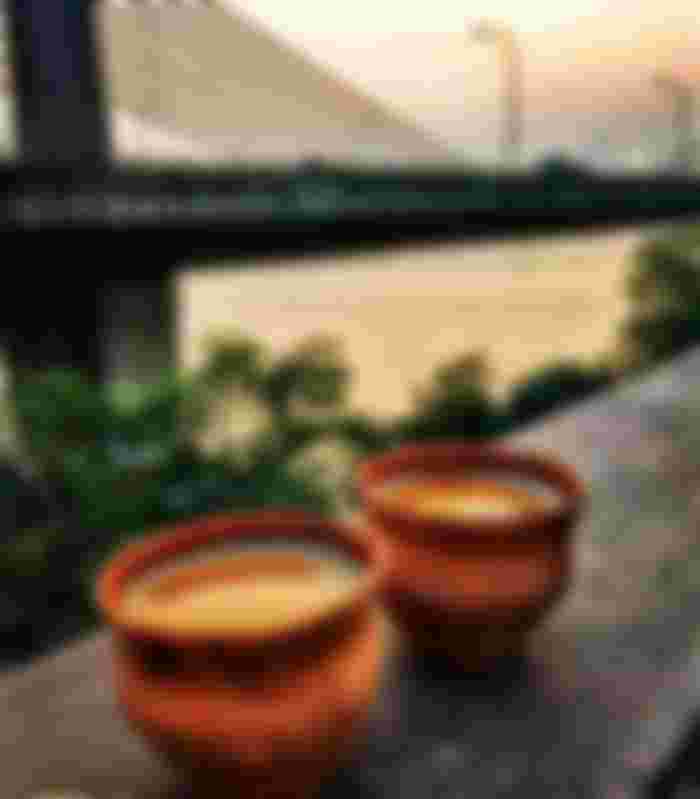
In many countries, it is not very cold in urban areas nowadays But the picture of winter in rural and urban areas was completely different in our childhood Does this generation enjoy the winter holidays as much as we did?
Among of those countries ,Bangladesh is one where winter impact lot of thing.
Yes this is about Bangladesh winter .Last 2 years ago i was go there for a project at winter season and i enjoy it very much .
now let me describe....
Winter comes after autumn. Fades the vicissitudes of life. Poush-Magh Two months before the onset of winter, some mild cold winds blow from the north. Then winter does not start in full swing. At night the fog falls on the leaves. The full winter starts from the month of Poush. The direction of the wind changes. Instead of summer monsoon, winter monsoon winds start blowing from the north-east. The air is cold as it flows from the northern region across the Himalayas. Moreover, at that time the sun moves south and in the northern hemisphere the sun's rays fall diagonally. So here the heat is less, in winter the night is bigger, the daytime is shorter. The heat that falls during the day and at night radiates throughout the evening. So heat is not transmitted. In winter, when the northeast monsoon winds blow, there is no sea vapor in the path, so there is no water vapor in the air. That is why it does not rain in winter in our country.
Our country is located in the tropics, so it doesn't feel too cold. Yet because of the winter we have to use warm clothes. However, most of the people in this country use cotton sheets during winter. If you don't have woolen cloth in winter major country, you can't protect yourself from winter. At present the government is distributing free winter clothes to the poor and helpless people at district, upazila and union level. The difference between winter and summer temperatures in our country is only 10 degrees. However, winter is more in the hilly areas. Due to the dryness of the air, winter falls more in remote areas than in coastal areas. As winter approaches, the fog envelops the area. The deeper the night, the colder it gets. The fog darkens all around - the paths are not visible. Winter is a curse for the poor in this country. Due to lack of clothes, the proletariat people with their sons and daughters are lying in broken huts with some kind of straw. Their house has no fence, no tent. This class of people suffers the most when it rains suddenly in winter.
There was a glimmer of winter earlier this month. Then there is no search. It is difficult to call it winter except for the fog of the morning and the light mist of the evening. The temperature in the capital was more than 26 degrees Celsius on Monday. It is almost hot in summer.
The Meteorological Department's data on the last 28 days of December is inconsistent with the winter of the other year. According to the agency, the average temperature in the country in December was less than 10 degrees Celsius for the last 50 years. Until yesterday this December, the temperature has exceeded 15 degrees Celsius.

As the temperature rises in winter, on the one hand, the use of electricity in the house is increasing and on the other hand, the winter crop in the field is also being damaged.
The Bangladesh Meteorological Department and the Norwegian Meteorological Institute jointly released a report on Bangladesh's climate last August. In the last 50 years, the average temperature in December has risen by 1.2 degrees Celsius.
Meteorologist Bazlur Rashid of the Meteorological Department was involved in the study. In the first light, he said, there is a similarity between the type of temperature rise in winter and the rise in global temperature. However, there is a link between rapid urbanization, declining wetlands and environmental degradation.

The report from the two companies further found that the winter is getting warmer and the dense fog is getting longer during this time. Rainfall in Madaripur, Mongla, Bhola, Feni and Satkhira has decreased by an average of 25 mm. The average rainfall in Teknaf-Khepupara and Cox's Bazar has increased by 25 mm. Additional rainfall is not required for rabi crops in rain-fed areas.
Last November, the Bangladesh Department of Environment sent a report on climate change to the United Nations. The report was prepared by the Bangladesh Center for Advanced Studies (BCAS). It also found that the average temperature in winter has risen by about 1 degree Celsius. The winter period has also been reduced by an average of six days.
In this regard, BCAS senior fellow Abu Syed told Prothom Alo that winter is coming 10 to 12 days late in Sylhet and northern areas. It will be more detrimental to the north, one of the major areas of winter crops. Because, wheat, potato and vegetables are produced there at this time.
Agriculture experts say the warming of winter could affect the production of several winter vegetables. They also fear that the taste and yield of potatoes, wheat, carrots, strawberries, broccoli, turnips and mulberries may be reduced, especially among winter-sensitive vegetables.
Professor Tofazzal Islam of Bangabandhu Sheikh Mujibur Rahman Agricultural University told Prothom Alo that recently several vegetables including strawberries and broccoli are being successfully cultivated in the country. The more these crops grow in winter, the better the yield will be. When winter decreases, the yield will also decrease. As temperatures rise in winter, winter vegetables can be greatly threatened.

Bacterial diseases are also on the rise in various winter vegetables due to increase in temperature and fog in winter. As a result, the use of bactericides in crops is also increasing. A 2015 study by the Bangladesh Agricultural Research Institute found that the use of pesticides was declining in the country due to increased cultivation of non-toxic crops. But the use of bactericides is increasing.
In this regard, meteorologist of the Meteorological Department of the Meteorological Department Shamim Ahsan told Prothom Alo, "Almost every year we see a long fog over a wide area including Bangladesh and India." At present the fog is coming towards Bangladesh through India. It will enter Bangladesh in a day or two. ”The meteorologist advised farmers to follow regular agricultural weather bulletins to protect their crops from fog.
Sediment-washed Bangladesh of the Padma-Meghna-Jamuna on the shores of the Bay of Bengal is a country of six seasons. Each season brings a different mood, a different mood to this country. In the numerical cycle of seasons, winter ranks fifth. The festival has a deep connection with winter. In rural Bengal, even in the cities, winter brings a festive mood. This festival has absolutely folk and natural features. The people of this country have an inseparable relationship with this festival. Winter is a special time of year, so this season is special for us.
Winter brings a big change in our daily life. The heat separates us, and the cold groups us. Festival is the gathering of people. People don't usually meet in one place without a festival. The image of this group of people can be seen everywhere in winter. In the fog-covered morning of the countryside, people sleep in the sun in the backyard, on the ghat, on the side of the road, on the platform of the tea shop, by the pond or the river. Men and women, children and teenagers, young and old, old and young. There are many stories going on for hours to take the sweet sun. Everyone thinks of a kind of merriment. This is how the winter day begins with small festivities.
In the middle of the day in the middle of the sky. At noon, the level of the festival varies. No matter what the work is, the wife and daughter-in-law of the house, even the men, will sit on the edge of the pond for a while before taking a bath. The same hangout at the end of the bath. The conversation doesn't seem to end.
In the evening, the festival gets another dimension. In the evenings in the countryside, it is another part of the winter festival to sit on the fire with straw, straw, burning herbs or making piles of wood. If the winter level is a little higher, such a picture can be seen in the city as well.
Even if you go to sleep at night, the winter festival reaches another level. In summer, family members usually spend the night in isolated places, keeping distance. In the sweltering heat, the situation is deplorable, there is no question of sleeping together. But winter nights bring isolated people together. The fun of sleeping under the same blanket or blanket is different. If you sleep together, the winter seems to be less. Through this group sleep, the long night covered with dew also became celebratory. In winter, during the day, there is a lot of excitement. Again in the night of contrast, he then surrenders himself to the stillness of solitude.

Apart from this, all the popular culture of rural Bengal is organized on winter nights. Such as — Kavigan, Jaripala, Murshidigan, Maghipurnima, Manik Pir's song, Patul dance, Mother Bamboo Jari, Maizbhandari song etc. No matter how much the cold air trembles on a foggy night, what else can stop the journey from being heard! In the winter night, Grambangla is known for organizing various types of drama songs. During the winter, different types of jatrapalas including Gazi's song, Manik Pir's song, Mother Pir's song can be seen in different parts of Bangladesh. Some of the jatrapalas are performed on the initiative of the common people of the village, as their hobby jatrapalas. Ordinary peasants, blacksmiths, potters, mute, van drivers, small traders and other professionals of the village themselves rehearse the journey in early winter. On the other hand, some professional travel teams with professional actors serve the winter travel. So there is a connection between winter and social and cultural festivals.
The food list also changes in winter. There are some innovations that not only carry the winter tradition, but also bring joy. In winter, new paddy grows in the houses of the village. This gives another dimension to the festival. The relationship of pithapuli with new paddy is inevitable. Winter morning without cake is like soil. Then the smell of eating cake fell in the house. The fun of eating hot cakes sitting next to the stove at home is different. In the morning mist or in the evening mist, the hot and fragrant smoke of steamed cake makes the mind restless. Putting mustard or coriander leaf paste or shuntki paste in the mouth of Chitai pitha, the ears become hot and winter escapes. In the morning, a cake festival can be seen in the village. The daughter, son-in-law and new family come to visit the house in winter to attend this Pithapuli festival. The parents make a cake and send it to the daughter-in-law's house in winter. There is also a matter of festival here.
In winter, date juice is an additional ingredient in food. The lovely earthen pot on the top of the date palm brings the message of winter festival. In the early hours of the morning, every house in the village was lit with date juice and everyone around the house started a fire. Some people take date juice to the market to sell. Chitai pitha is made at night and soaked in date juice and eaten in the morning is possible only in winter. And there is no comparison between ‘raab’ made from date juice. At this time the smoke of making molasses from sugarcane juice fell. The taste of eating hot molasses is different. This is another aspect of the winter festival.
Variety is also seen in winter vegetables. How many types of vegetables are not available in the market in winter! Fresh vegetables including radish, vendi, gourd, pumpkin, squash, cabbage, cauliflower, potato, eggplant, tomato, cucumber, carrot, bean, bean sprouts are available in winter. As a result, the feast in winter also becomes a kind of festival.
And there is no winter option for travel. In winter the roads are dry, the sky is cloudless, there is no fear of storms, floods and cyclones; So everyone chooses this time to travel. The number of tourists visiting Cox's Bazar, Teknaf, St. Martin's, Chittagong, Bandarban, Khagrachhari, Nijhumdwip, Sundarbans, Patuakhali, Sylhet and other tourist destinations of the country in winter is unmatched in any other season. As if the arrival of winter for travel! And travel means festival joy. For travelers, this season brings a festive message.
As the water recedes from the field in winter, the horizon is suitable for the people of the field to move, which is unsuitable in the rainy season. Horizon mustard fields, yellow spread. In the middle of it, there is no obstacle to go from village to village along the dirt road. The movement of people also increased at this time. This season marks the end of the bride's wait to visit relatives and visit her father's house from a distant village. The brides of the village come to Nairobi, the father's house. The village markets also became crowded. Grambangla became really festive at this time with the opportunity to wander around as desired.
Poush Sankranti or Makar Sankranti is a special festival day in Bengali culture. It is also an accompaniment to the winter festivities; Although it is not celebrated in all regions of the country. This festival is celebrated on the last day of Bengali Poush month. On this day Bengalis organize various kinds of events. One of them is eating cake and flying kites. After flying kites all day, in the evening the festival is concluded by blowing firecrackers and blowing lanterns.
Variety is also noticeable in winter clothing. A combination of varied clothes on everyone, big and small. Coats, blazers, jumpers, sheets, caps, monkey caps — these dresses bring a festive look. Only winter is suitable for wearing fashionable clothes. Winter is therefore a symbol of prosperity. Behind the winter fog, nature is created for spring. Winter brings a message of joy to rural Bengal, but it also brings sorrow to some. Cold-stricken people, who can't afford to buy winter clothes, we should stand by them.
The fair is a moving living tradition. Mela means reunion, bond, festival. In Bengali, the word 'mela' refers to many or many. The place where many people meet for a special purpose, the place where various goods are sold, is generally known to us as a fair. The fair is an uninterrupted wilderness of meeting people, interacting in culture, overcoming class divisions. Different types of fairs are seen to have originated due to religious reasons, seasonal reasons or commemoration of any person or event. However, in terms of character, all the fairs are almost the same. The gathering of many people, the bikinis of all kinds of goods this simple concept has in a sense made the fair a universal character. It is one of the main centers for expressing, nurturing or practicing the cultural diversity of a nation or group. Fairs showcase the diverse cultural elements of a nation or group. One of its various features is that as a marketing center, it prevents the extinction of various local industries.
Each season has different characteristics. Winter is no exception. The connection of the seasons with the fair may have been very close and connected because the seasons and the form-juice-smell of nature work deeply on the human mind. Winter is a little ahead of other seasons in this country of conspiracy as the best time to organize fairs. Evidence of this can be found in Mokaram Hossain's Bangladesh Mela book. This book mentions about 255 fairs in different parts of Bangladesh in the months of Poush and Magh alone. Of these, 108 fairs were held in Poush and 146 in Magh. The big fairs like Khanjeli fair in Bagerhat, fish fair in Moulvibazar, horse race fair in Magura, Maizbhandari fair in Chittagong, fish fair in Poradaha in Bogra etc. are held almost all in winter.
Crop planting and harvesting are two important factors in agricultural culture. Keeping these two occasions in mind in the continuity of traditional culture, the people of Bengal, who depend on agro-based economy and culture, celebrate with joy. Agrahayan is the month of harvest. The farmers are busy at this time as the crops are harvested from the field mainly during the agrahayan month. At the beginning of winter, when the crop of the land grows in the house, the farmer has complete rest. At this time, you can leave your arms and legs and sit motionless for a whole year. During this leisure time, the rural areas wake up through various aspects of their own culture, such as songs, plays, games, etc. In other words, a spontaneous arrangement of the festival is in sight at this time. The huge open field required for organizing these is also readily available at this time as there is no crop in the field. This makes it easier to organize horse races, puppet dances or rides; Which are very popular aspects of the festival in rural society. These are not possible to organize at other times of the year as there are field-filled crops. At this time there is no shortage of raw money to sell crops in the hands of farmers. The fair is organized spontaneously as there is money in hand. Huge open field, raw money in hand and the practice of leisure and benevolence of the majority of the population এই this simple equation of holding winter fairs in villages from time immemorial can be inferred on the basis of general information of the early history of Bengal. Moreover, it can be said that there are no natural calamities in the winter to disrupt the festival. Whatever is there is also very fleeting. This is also a big reason why winter is considered as the ideal time to organize fairs.

At the end of all, I am concluding with a few steps of Rabindranath Tagore in the context of winter: The wind blows ,,Death takes them away ...
They turn around in the dry leaves ,,In the air full of trembling frost.
Fallen flower petals cover them ,,Why do they loot after the dead grass.
Is it all day.??Will they say goodbye? Now I understand that in the fog ,, they hide and go to the dusty night ,,,to respond to the call of the dust .
where on the ground ,, you are alone, dear, ,, are you sitting in your mind / with the head of the region? ... in the cold winter .In the gap of the naked branch ....






I prefer winter too